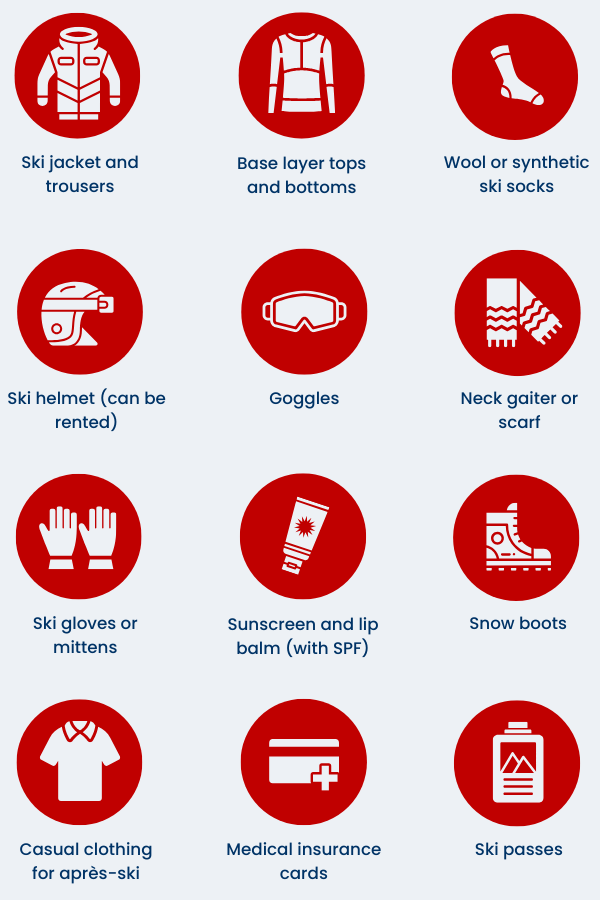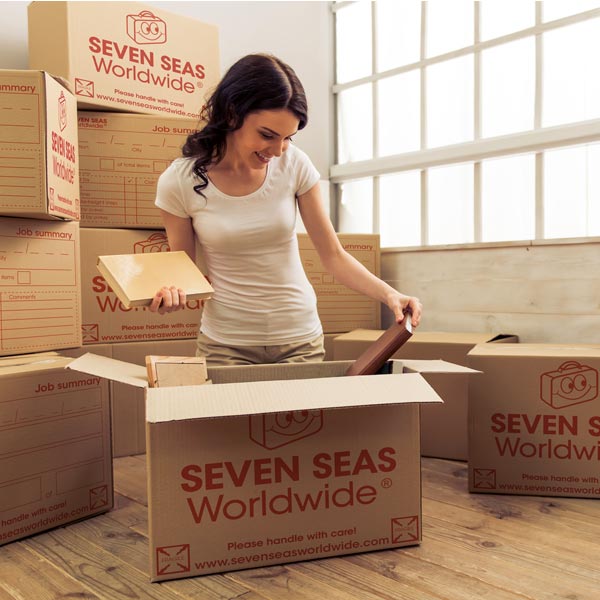Before packing, check this list of items prohibited from entering a particular country or region.
Key takeaways
- To ship skis, clean and dry them, remove or bind the brakes, cover the skis with plenty of bubble wrap, pack them side by side in either a hard case or cardboard ski box, and send them to their destination using a trusted overseas shipping company.
- To pack skis in a ski bag, place your clean skis in the centre of the bag with the poles on either side (their tips covered in bubble wrap to stop scratching), and add soft clothing, such as t-shirts and fleeces, for extra padding.
- Skis weigh between 4kg (around 9 lbs) and 7kg (around 16 lbs), depending on their length, material, and design.
Quick links
How to ship skis | How much do skis weigh? | How to pack skis in ski bag

Best way to ship skis
The best way to ship skis is to clean and dry them thoroughly (including the poles and ski bag), remove or secure the brakes, measure the skis, and pack them into a hard shell ski box or a double-walled cardboard ski box filled with cushioning materials. Add a "Fragile" label and use a reputable shipping company that offers tracking, insurance, customs support, and door-to-door delivery.
How to ship skis
To ship skis, start by cleaning and drying them alongside your poles — this ensures everything arrives clean and ready to use at the destination and helps avoid the potential import of organic matter, which many countries, including Japan, Australia, and New Zealand, strictly forbid. Use a soft cloth and warm water to remove dirt or grime, but avoid harsh detergents that can strip away the skis' protective layers. Remember to dry them thoroughly, especially the skis' edges and bindings, to prevent rust. Finish by applying a light coat of wax* to each ski's base for added protection.
Then, take off or bind the brakes. If removable, ship them in a separate box alongside your other ski accessories, like boots, gloves, helmets, and goggles. Otherwise, use a zip tie to prevent the brakes from sticking out and ripping your ski bag or shipping box during transit.
Next, measure the skis to ensure you choose an appropriate shipping box. Keep in mind that shipping companies often have size limits. Ensure that the bindings, ends of the skis (which often receive the greatest impact), and other vulnerable parts are protected with several layers of protective packaging, such as bubble wrap, inflatable air cushions, or cardboard sealed with packing tape, to avoid any damage during transport.
If possible, purchase a hard-shell ski box* for ultimate protection. Otherwise, place your tip-to-tail skis and your poles inside a double-walled cardboard ski box with enough room to accommodate the padded areas. Fill any gaps in the box with soft packaging materials such as packing paper or crumpled newspaper to minimise movement. Then, seal the box tightly with thick packing tape, reinforcing all seams and edges. Add a "Fragile" sticker to help reduce rough handling.
Finally, choose an overseas shipping company to collect and deliver your skis safely. Consider reputation, reliability, cost, and the range of services offered, including:
- Tracking: many shipping companies let you monitor your skis in real-time throughout the shipping process for extra peace of mind.
- Insurance: look for comprehensive insurance options to cover loss or damage, particularly if you are shipping valuable or high-end equipment.
- Customs clearance: expert shippers can navigate complex customs procedures on your behalf, ensuring your skis avoid unexpected delays, quarantine, or penalties.
- Door-to-door delivery: many shipping services take care of all the logistics, saving you precious time and effort.
- Faster shipping: if you need your skis by a specific date, check for expedited shipping services, usually via air shipping.
*Seven Seas Worldwide does not endorse these products.

Ski trip packing list
In your ski trip packing list alongside your skiing equipment, remember to include waterproof and insulated outerwear, moisture-wicking base and mid-layers, gloves, socks, helmet (although these can be rented), goggles, neck warmer, warm casual clothing for evenings, sunscreen and lip balm containing SPF, medical insurance cards and skit/lift passes.

How much do skis weigh?
Skis weigh between 4kg (around 9 lbs) and 7kg (around 16 lbs), depending on their length, material, and design. Shorter skis, like freestyle or cross-country styles, weigh about 3kg (around 7 lbs) to 5kg (around 11 lbs). Heavier models, such as all-mountain or powder skis, can weigh up to 8kg (around 18 lbs) or more.
Bindings and brakes usually add another 1.5kg (around 4 lbs) to 2kg (around 5 lbs) per pair. If you include poles, padding, and a case, the total weight could reach 8kg (around 18 lbs) for a cardboard case or 10kg (around 22 lbs) for a hard case. Always check your international shipping company's weight limits; exceeding them may lead to extra charges.
Place small soft items like socks, underwear and hats inside your ski boots to maximise space.

How to pack skis in ski bag
To pack skis in a ski bag, first, thoroughly remove all dirt and moisture from the skis and remove or bind the brakes with zip ties, Velcro straps, or a rubber band to keep them secure and prevent damage during transit.
Next, place your clean skis side by side in the centre of the bag (opt for a large padded ski bag*!), with the poles on either side and their tips covered in bubble wrap to stop scratching. If packing boots, place them at the bottom to shift the weight, making them easier to transport.
Place small soft items like socks, underwear and hats inside your ski boots to maximise space. Layer soft clothing, such as t-shirts, sweaters and fleeces, on top of the skis for added padding, and tuck delicate items like goggles and sunglasses between the layers. If you're heading off-piste, add your avalanche transceiver* (with batteries removed) and a shovel.
Keep everything snug to prevent movement inside the bag. If there are gaps, fill them with more cushioning materials, such as clothing, towels, or foam sheets that you can cut into shape*. Zip the bag and fasten any straps or buckles.
Top tip: carry your custom boots and helmet as hand luggage to lighten your ski bag and keep your tailored gear safely with you at all times.
*Seven Seas Worldwide does not endorse these products.
Ski shipping box: cardboard or hard case?
When choosing a ski shipping box, your two main options are a cardboard box or a hard case, depending on how often you travel and your budget. A hard case is usually the better long-term choice for frequent travellers or those sending high-value equipment. However, a properly packed cardboard box would suffice for occasional users.
Cardboard boxes cost less and are lighter, lowering shipping costs. However, ensure you choose double-walled cardboard for extra protection. They are ideal for one-off trips, provided you securely pack your skis with bubble wrap or other padding materials.
A hard case is more expensive but better protects your skis. Made from high-impact plastic or polycarbonate, it shields your skis from moisture and rough handling during transport. Many hard cases are lockable and come with wheels, making them easier to move. However, they're heavier, which can push up fees. You can also buy soft bags for skis, but ensure you pack clothes around them to take up space, prevent movement, and make the skis more secure.













